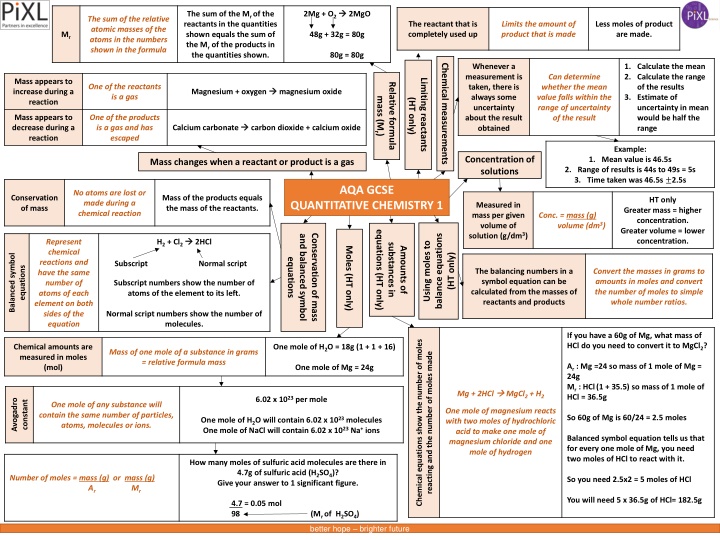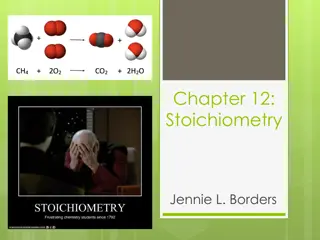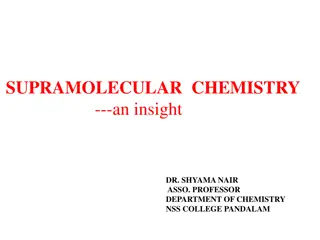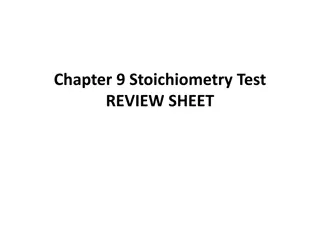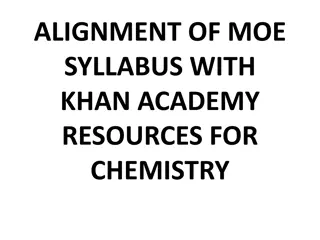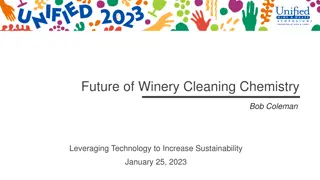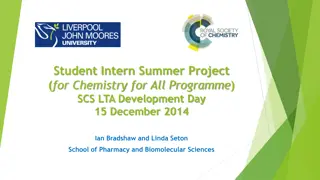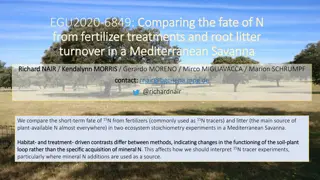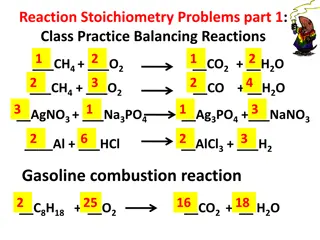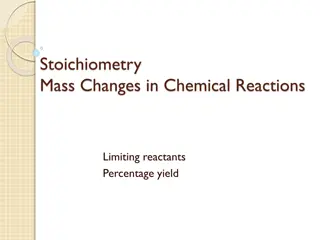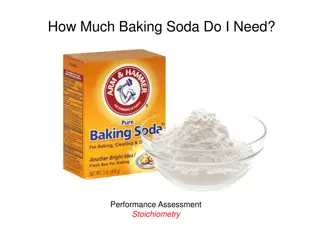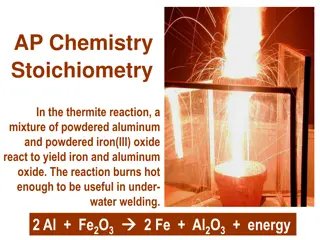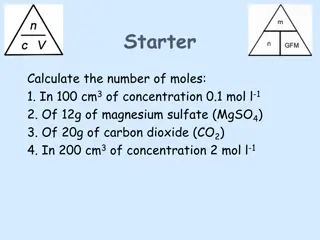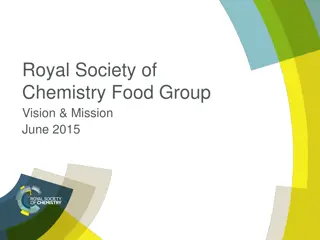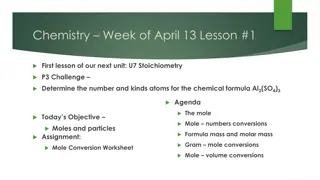Stoichiometry in Chemistry
The study of mathematical relationships in balanced chemical reactions for calculating reactant and product amounts, applying skills to convert between moles and masses of different compounds. Explore coefficients, mole ratios, and examples to understand stoichiometry fundamentals.
Download Presentation

Please find below an Image/Link to download the presentation.
The content on the website is provided AS IS for your information and personal use only. It may not be sold, licensed, or shared on other websites without obtaining consent from the author.If you encounter any issues during the download, it is possible that the publisher has removed the file from their server.
You are allowed to download the files provided on this website for personal or commercial use, subject to the condition that they are used lawfully. All files are the property of their respective owners.
The content on the website is provided AS IS for your information and personal use only. It may not be sold, licensed, or shared on other websites without obtaining consent from the author.
E N D
Presentation Transcript
2Mg + O2 2MgO The sum of the Mr of the reactants in the quantities shown equals the sum of the Mr of the products in the quantities shown. The sum of the relative atomic masses of the atoms in the numbers shown in the formula The reactant that is completely used up Limits the amount of product that is made Less moles of product are made. Mr 48g + 32g = 80g 80g = 80g Chemical measurements Whenever a measurement is taken, there is always some uncertainty about the result obtained 1. Calculate the mean 2. Calculate the range of the results 3. Estimate of uncertainty in mean would be half the range Can determine whether the mean value falls within the range of uncertainty of the result Limiting reactants Mass appears to increase during a reaction Relative formula One of the reactants is a gas Magnesium + oxygen magnesium oxide (HT only) mass (Mr) Mass appears to decrease during a reaction One of the products is a gas and has escaped Calcium carbonate carbon dioxide + calcium oxide Example: Concentration of solutions 1. Mean value is 46.5s 2. Range of results is 44s to 49s = 5s 3. Time taken was 46.5s 2.5s Mass changes when a reactant or product is a gas AQA GCSE No atoms are lost or made during a chemical reaction Conservation of mass Mass of the products equals the mass of the reactants. HT only QUANTITATIVE CHEMISTRY 1 Measured in mass per given volume of solution (g/dm3) Greater mass = higher concentration. Greater volume = lower concentration. Conc. = mass (g) . volume (dm3) equations (HT only) balance equations Conservation of mass and balanced symbol H2 + Cl2 2HCl Represent chemical reactions and have the same number of atoms of each element on both sides of the equation Using moles to substances in Moles (HT only) Amounts of Balanced symbol (HT only) equations Subscript Normal script equations The balancing numbers in a symbol equation can be calculated from the masses of reactants and products Convert the masses in grams to amounts in moles and convert the number of moles to simple whole number ratios. Subscript numbers show the number of atoms of the element to its left. Normal script numbers show the number of molecules. If you have a 60g of Mg, what mass of HCl do you need to convert it to MgCl2? Chemical equations show the number of moles Chemical amounts are measured in moles (mol) One mole of H2O = 18g (1 + 1 + 16) Mass of one mole of a substance in grams = relative formula mass reacting and the number of moles made Ar : Mg =24 so mass of 1 mole of Mg = 24g Mr : HCl(1 + 35.5) so mass of 1 mole of HCl = 36.5g One mole of Mg = 24g Mg + 2HCl MgCl2 + H2 6.02 x 1023 per mole Avogadro constant One mole of any substance will contain the same number of particles, atoms, molecules or ions. One mole of magnesium reacts with two moles of hydrochloric acid to make one mole of magnesium chloride and one mole of hydrogen So 60g of Mg is 60/24 = 2.5 moles One mole of H2O will contain 6.02 x 1023 molecules One mole of NaCl will contain 6.02 x 1023 Na+ ions Balanced symbol equation tells us that for every one mole of Mg, you need two moles of HCl to react with it. How many moles of sulfuric acid molecules are there in 4.7g of sulfuric acid (H2SO4)? Give your answer to 1 significant figure. Number of moles = mass (g) or mass (g) Ar So you need 2.5x2 = 5 moles of HCl Mr You will need 5 x 36.5g of HCl= 182.5g 4.7 = 0.05 mol 98 (Mr of H2SO4) better hope brighter future
2Mg + O2 2MgO The sum of the Mr of the reactants in the quantities shown equals the sum of the Mr of the products in the quantities shown. The sum of the relative atomic masses of the atoms in the numbers shown in the formula Limits the amount of product that is made Less moles of product are made. 48g + 32g = 80g 80g = 80g Chemical measurements 1. Calculate the mean 2. Calculate the range of the results 3. Estimate of uncertainty in mean would be half the range Can determine whether the mean value falls within the range of uncertainty of the result Limiting reactants Relative formula One of the reactants is a gas Magnesium + oxygen magnesium oxide (HT only) mass (Mr) One of the products is a gas and has escaped Calcium carbonate carbon dioxide + calcium oxide Example: Concentration of solutions 1. Mean value is 46.5s 2. Range of results is 44s to 49s = 5s 3. Time taken was 46.5s 2.5s Mass changes when a reactant or product is a gas AQA GCSE No atoms are lost or made during a chemical reaction Mass of the products equals the mass of the reactants. HT only QUANTITATIVE CHEMISTRY 1 Greater mass = higher concentration. Greater volume = lower concentration. Conc. = mass (g) . volume (dm3) equations (HT only) balance equations Conservation of mass and balanced symbol H2 + Cl2 2HCl Represent chemical reactions and have the same number of atoms of each element on both sides of the equation Using moles to substances in Moles (HT only) Amounts of (HT only) equations Subscript Normal script Convert the masses in grams to amounts in moles and convert the number of moles to simple whole number ratios. Subscript numbers show the number of atoms of the element to its left. Normal script numbers show the number of molecules. If you have a 60g of Mg, what mass of HCl do you need to convert it to MgCl2? One mole of H2O = 18g (1 + 1 + 16) Mass of one mole of a substance in grams = relative formula mass Ar : Mg =24 so mass of 1 mole of Mg = 24g Mr : HCl(1 + 35.5) so mass of 1 mole of HCl = 36.5g One mole of Mg = 24g Mg + 2HCl MgCl2 + H2 6.02 x 1023 per mole One mole of any substance will contain the same number of particles, atoms, molecules or ions. One mole of magnesium reacts with two moles of hydrochloric acid to make one mole of magnesium chloride and one mole of hydrogen So 60g of Mg is 60/24 = 2.5 moles One mole of H2O will contain 6.02 x 1023 molecules One mole of NaCl will contain 6.02 x 1023 Na+ ions Balanced symbol equation tells us that for every one mole of Mg, you need two moles of HCl to react with it. How many moles of sulfuric acid molecules are there in 4.7g of sulfuric acid (H2SO4)? Give your answer to 1 significant figure. Number of moles = mass (g) or mass (g) Ar So you need 2.5x2 = 5 moles of HCl Mr You will need 5 x 36.5g of HCl= 182.5g 4.7 = 0.05 mol 98 (Mr of H2SO4) better hope brighter future
2Mg + O2 2MgO The sum of the Mr of the reactants in the quantities shown equals the sum of the Mr of the products in the quantities shown. Less moles of product are made. 48g + 32g = 80g 80g = 80g Chemical measurements 1. Calculate the mean 2. Calculate the range of the results 3. Estimate of uncertainty in mean would be half the range Limiting reactants Relative formula Magnesium + oxygen magnesium oxide (HT only) mass (Mr) Calcium carbonate carbon dioxide + calcium oxide Example: Concentration of solutions 1. value is 46.5s 2. of results is 44s to 49s = 5s 3. was 46.5s 2.5s Mass changes when a reactant or product is a gas AQA GCSE Mass of the products equals the mass of the reactants. QUANTITATIVE CHEMISTRY 1 Conc. = mass (g) . volume (dm3) equations (HT only) balance equations Conservation of mass and balanced symbol H2 + Cl2 2HCl Using moles to substances in Moles (HT only) Amounts of (HT only) equations Subscript Normal script Convert the masses in grams to amounts in moles and convert the number of moles to simple whole number ratios. Subscript numbers show the number of atoms of the element to its left. Normal script numbers show the number of molecules. If you have a 60g of Mg, what mass of HCl do you need to convert it to MgCl2? One mole of H2O = 18g (1 + 1 + 16) Ar : Mg =24 so mass of 1 mole of Mg = 24g Mr : HCl(1 + 35.5) so mass of 1 mole of HCl = 36.5g One mole of Mg = 24g Mg + 2HCl MgCl2 + H2 6.02 x 1023 per mole One mole of magnesium reacts with two moles of hydrochloric acid to make one mole of magnesium chloride and one mole of hydrogen So 60g of Mg is 60/24 = moles One mole of H2O will contain 6.02 x 1023 molecules One mole of NaCl will contain 6.02 x 1023 Na+ ions Balanced symbol equation tells us that for every one mole of Mg, you need two moles of HCl to react with it. How many moles of sulfuric acid molecules are there in 4.7g of sulfuric acid (H2SO4)? Give your answer to 1 significant figure. So you need = 5 moles of HCl You will need = 182.5g 4.7 = 0.05 mol 98 (Mr of H2SO4) better hope brighter future
2Mg + O2 2MgO 48g + 32g = 80g 80g = 80g Chemical measurements 1. Limiting reactants Relative formula 2. Magnesium + oxygen . (HT only) mass (Mr) 3. Calcium carbonate . Example: Concentration of solutions 1. value is 46.5s 2. of results is 44s to 49s = 5s 3. was 46.5s 2.5s Mass changes when a reactant or product is a gas AQA GCSE Mass of the products equals the mass of the reactants. HT QUANTITATIVE CHEMISTRY 1 Equation equations (HT only) balance equations Conservation of mass and balanced symbol H2 + Cl2 2HCl Using moles to substances in Moles (HT only) Amounts of (HT only) equations Subscript Normal script Convert the masses in grams to amounts in moles and convert the number of moles to simple whole number ratios. One mole of H2O = 18g (1 + 1 + 16) One mole of Mg = 24g Mg + 2HCl MgCl2 + H2 6.02 x 1023 per mole One mole of magnesium reacts with two moles of hydrochloric acid to make one mole of magnesium chloride and one mole of hydrogen One mole of H2O will contain One mole of NaCl will contain How many moles of sulfuric acid molecules are there in 4.7g of sulfuric acid (H2SO4)? Give your answer to 1 significant figure. better hope brighter future
